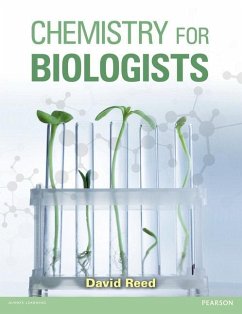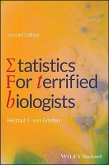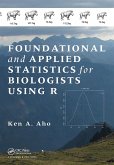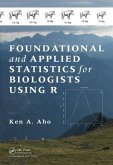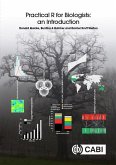'The text is clear, readable, and seeks to put difficult concepts in chemistry into context, explaining why a biologist will need to understand them. It is ideal for self-directed learning and I have every intention of recommending it to my students.'Professor John Nicholson, St Mary's University College, Twickenham
'I think this text is ground-breaking; it is ideal for bioscience students and covers all the chemical basics I would expect (and more). I will take great pleasure using this as a resource for my students.' Dr. Mark Howard, School of Biosciences, University of Kent Chemistry for Biologists provides a focused yet chemically and mathematically rigorous introduction to those key aspects of chemistry that form the basis of biological processes.
Written in a straightforward, accessible style, the book begins with an overview of basic chemical concepts. Building on these core principles, the reader is guided through subjects such as the structures and properties of organic molecules, equilibria, energetics, kinetics, biomolecules, reaction mechanisms, metabolism and structural methods. The relevance of each chemical concept to the study of biology is clearly explained at every stage, enabling students to develop a deep appreciation of the chemistry that underpins their chosen subject, and become confident in applying this knowledge to their own studies.
Key features
· Comprehensively covers the chemistry needed by all students seeking to understand biological processes at a fundamental level.
· Numerous boxed features highlight key ideas and explore more advanced concepts.
· Contains a wealth of engaging examples throughout the text, applying the theory to biology in practice.
· Self-test question sets at the end of each chapter are included to help consolidate understanding of key concepts, and full answers are supplied at the back to enable students to assess their own progress.
· An appendix of basic mathematical tools for biochemistry is included to help explain key mathematical concepts and, crucially, their relevance to the subject.
For biology and biosciences undergraduates with little background in chemistry who need to bring their skills up to scratch quickly, and any students who wish to develop their confidence in chemistry to take their studies further, this book will be an invaluable resource.
Dr David Reed holds an honorary fellowship with the University Of Edinburgh. He has extensive experience in delivering chemistry courses to students of biological sciences.
Features + Benefits
Comprehensively covers the chemistry needed by all students seeking to understand biological processes at a fundamental level.
Numerous boxed features highlight key ideas and explore more advanced concepts.
Contains a wealth of engaging examples throughout the text, applying the theory to biology in practice.
Self-test question sets at the end of each chapter are included to help consolidate understanding of key concepts, and full answers are supplied at the back to enable students to assess their own progress.
An appendix of basic mathematical tools for biochemistry is included to help explain key mathematical concepts and, crucially, their relevance to the subject.
Backcover
'The text is clear, readable, and seeks to put difficult concepts in chemistry into context, explaining why a biologist will need to understand them. It is ideal for self-directed learning and I have every intention of recommending it to my students.' Professor John Nicholson, St Mary's University College, Twickenham
'I think this text is ground-breaking; it is ideal for bioscience students and covers all the chemical basics I would expect (and more). I will take great pleasure using this as a resource for my students.' Dr Mark Howard, School of Biosciences, University of Kent Chemistry for Biologists provides a focused yet chemically and mathematically rigorous introduction to those key aspects of chemistry that form the basis of biological processes.
Written in a straightforward, accessible style, the book begins with an overview of basic chemical concepts. Building on these core principles, the reader is guided through subjects such as the structure and properties of organic molecules, equilibria, energetics, kinetics, biomolecules, reaction mechanisms, metabolism and structural methods. The relevance of each chemical concept to the study of biology is clearly explained at every stage, enabling students to develop a deep appreciation of the chemistry that underpins their chosen subject, and become confident in applying this knowledge to their own studies.
Key features
· Comprehensively covers the chemistry needed by all students seeking to understand biological processes at a fundamental level.
· Numerous boxed features highlight key ideas and explore more advanced concepts.
· Contains a wealth of engaging examples throughout the text, applying the theory to biology in practice.
· Self-test question sets at the end of each chapter are included to help consolidate understanding of key concepts, and full answers are supplied at the back to enable students to assess their own progress.
· An appendix of basic mathematical tools for biochemistry is included to help explain key mathematical concepts and, crucially, their relevance to the subject.
For biology and biosciences undergraduates with little background in chemistry who need to bring their skills up to scratch quickly, and any students who wish to develop their confidence in chemistry to take their studies further, this book will be an invaluable resource.
Dr David Reed holds an honorary fellowship with the University of Edinburgh. He has extensive experience in delivering chemistry courses to students of biological sciences.
Contents
Preface
Acknowledgements
Chapter 1 Basic Concepts
1.1 Introduction
1.1.1 The states of matter
1.1.2 Elements, Compounds and Mixtures
1.2 Measurement and units
1.2.1 Scales of units
1.2.2 A review of some commonly used measurements
1.2.3 Accuracy and precision
1.3 Atoms
1.3.1 Isotopes
1.3.2 Isotopes, radioactivity and the types of radiation
1.3.3 Electrons
1.3.4 Molecules
1.4 The concepts of stoichiometry: calculations of quantity in chemistry
1.4.1 Introduction
1.4.2 Avogadroզs number and the concept of the mole
1.4.3 Formulae and molecular mass
1.4.4 Mass percent composition
1.4.5 Empirical and molecular formulae
1.4.6 Writing and Balancing Chemical Equations
1.4.7 Balancing Equations: A systematic approach
1.4.8 Moles and masses
1.4.9 Concentration of solutions
Questions
Chapter 2. Atoms, Periodicity and Chemical Bonding
2.1 Electronic structure
2.2 Electromagnetic radiation
2.3 The Bohr Model of the Atom
2.4 An introduction to atomic orbitals
2.5 Electron configurations in atoms
2.6 The periodic table
2.6.1 Periodic properties
2.7 An introduction to bonding. How atoms become molecules.
2.7.1 Introduction
2.7.2 Ionic Bonding
2.7.3 Covalent Bonding
2.7.4 Formaloxidation states
2.7.5 Polarisation: covalent or ionic bonding?
2.7.6 Metallic Bonding
2.7.7 Shapes of molecules ΥV the VSEPR approach
2.7.8 Resonance
2.8 Covalent bonding ΥV atomic and molecular orbitals
2.9 Intermolecular Forces
2.9.1 Dipole-dipole interactions
2.9.2 Dispersion (London) Forces
2.9.3 Hydrogen Bonding
2.9.4 Biological implications of hydrogen bonding
Questions
Chapter 3. An Introduction to the Chemistry of Carbon
3.1 Introduction
3.2 Properties of carbon
3.3 Classification of organic molecules
3.3.1 Nomenclature (naming) of organic compounds
3.3.2 Systematic Nomenclature
3.3.3 Introduction to the Functional Groups concept
3.3.4 Naming of aliphatic compounds containing functional groups
3.4 The structure of organic molecules
3.4.1 Structural features of organic chemistry
3.4.2 Introduction to isomerism
3.4.3 Structural/constitutional isomerism
3.4.4 Introduction to stereoisomerism
3.4.5 Conformation
3.4.6 Introduction to configurational isomerism
3.4.7 Geometrical isomerism
3.4.8 Symmetry, chirality and optical isomerism
3.4.9 Why is shape important? ΥV some examples.
Questions
Chapter 4 Energetics
4.1 Introduction
4.1.1 The idea of energy
4.1.2 Energy: heat, work and the first law of thermodynamics
4.2 Temperature and Heat
4.2.1 The nature of heat
4.2.2 Heat capacity, C and specific heat capacity, c
4.2.3 Endothermic and Exothermic Processes
4.3 The First Law of Thermodynamics ΥV introducing the concept of work
4.3.1 The Nature of Work
4.3.2 Energy in the chemistry context
4.3.3 The Concept of Enthalpy
4.3.4 Examples of enthalpy changes in biological processes
4.3.5 The Determination of Enthalpies: Hessզs Law
4.4 Spontaneous processes, entropy and free energy
4.4.1 The 2nd Law of thermodynamics.
4.4.2 Free energy and ATP: Coupling of reactions
4.4.3 Biological example: Thermodynamic rationale of micelle behaviour
Questions
Chapter 5 Equilibria: How far does a reaction go?
5.1 Introduction
5.2 Developing the idea of equilibrium: the equilibrium constant
5.2.1 Calculation of equilibrium constants and concentrations
5.3 Equilibrium and energetics
5.3.1 Background
5.3.2 The reaction quotient
5.3.3 Calculating equilibrium constants in the gas phase, using partial pressures; Kp
5.4 The relationship between īGć and K.
5.4.1 A more detailed look at reaction quotient Q and equilibrium constant, K.
5.5 Disturbing an equilibrium
5.5.1 Statement of Le Chatelierզs Principle
5.5.2 Le Chatelierզs principle and the effect of temperature on equilibria.
5.5.3 Examples involving Le Chatelierզs principle
5.6 Energetics and equilibria in the biological context.
5.6.1 Calculating ƒ´GΥò from experimentally determined compositions (via K values)
5.6.2 Calculating equilibrium compositions from ƒ´GΥò
5.6.3 Macromolecule-ligand interactions.
5.6.4 Haemoglobin - oxygen
5.7 Revisiting coupled reactions
Questions
Chapter 6 Aqueous Equilibria
6.1 Introduction
6.1.1 Why is this important in biology?
6.1.2 The importance of pH and pH control
6.2 Self ionisation of water
6.3 Acids and bases
6.3.1 What do the terms acid and base mean?
6.3.2 Properties of acids
6.3.3 Properties of bases6.3.4 Strong acids and strong bases
6.4 AcidΥVbase equilibria
6.4.1 Behaviour of weak acids
6.4.2 Behaviour of weak bases
6.5 Dissociation of acids and bases - conjugate acids and bases
6.6 Acids and bases in aqueous solution ΥV the concept of pH
6.6.1 Definition
6.6.2 What happens when acids are dissolved in water?
6.6.3 What happens when the water equilibrium is disturbed
6.6.4 Calculating pH values for acids
6.7 The control of pH - buffer solutions
6.7.1 Background
6.7.2 Theoretical aspects of buffers
6.7.3 General Strategy for making buffer solutions
6.8 Polyprotic acids
6.9 Salts
6.9.1 Titrations
6.10 Introducing solubility
6.10.1 Insoluble ionic compounds. The concept of solubility product.
6.10.2 The common ion effect
Questions
Chapter 7 Biomolecules and biopolymers
7.1 Introduction
7.2 Lipids
7.2.1 Fats, oils and fatty acids
7.2.2 Triglyceride fats
7.2.3 Uses of fats - micelles
7.2.4 Phospholipids
7.2.5 Waxes
7.2.6 Steroids
7.3 Carbohydrates
7.3.1 Monosaccharides
7.3.2 Carbohydrate stereochemistry
7.3.3 Cyclisation in sugars
7.3.4 Di- and polysaccharides
7.4 Amino acids, peptides and proteins
7.4.1 Introduction
7.4.2 Acid-base behaviour of amino acids: zwitterions
7.4.3 The isoelectric point
7.4.4 The stereo
Chemistry for Biologists provides a focused yet chemically and mathematically rigorous introduction to those key aspects of chemistry that form the basis of biological processes. Written in a straightforward, accessible style, the book begins with an overview of basic chemical concepts. Building on these core principles, the reader is guided through subjects such as the structure and properties of organic molecules, equilibria, energetics, kinetics, biomolecules, reaction mechanisms, metabolism and structural methods. The relevance of each chemical concept to the study of biology is clearly explained at every stage, enabling students to develop a deep appreciation of the chemistry that underpins their chosen subject, and become confident in applying this knowledge to their own studies.
'I think this text is ground-breaking; it is ideal for bioscience students and covers all the chemical basics I would expect (and more). I will take great pleasure using this as a resource for my students.' Dr. Mark Howard, School of Biosciences, University of Kent Chemistry for Biologists provides a focused yet chemically and mathematically rigorous introduction to those key aspects of chemistry that form the basis of biological processes.
Written in a straightforward, accessible style, the book begins with an overview of basic chemical concepts. Building on these core principles, the reader is guided through subjects such as the structures and properties of organic molecules, equilibria, energetics, kinetics, biomolecules, reaction mechanisms, metabolism and structural methods. The relevance of each chemical concept to the study of biology is clearly explained at every stage, enabling students to develop a deep appreciation of the chemistry that underpins their chosen subject, and become confident in applying this knowledge to their own studies.
Key features
· Comprehensively covers the chemistry needed by all students seeking to understand biological processes at a fundamental level.
· Numerous boxed features highlight key ideas and explore more advanced concepts.
· Contains a wealth of engaging examples throughout the text, applying the theory to biology in practice.
· Self-test question sets at the end of each chapter are included to help consolidate understanding of key concepts, and full answers are supplied at the back to enable students to assess their own progress.
· An appendix of basic mathematical tools for biochemistry is included to help explain key mathematical concepts and, crucially, their relevance to the subject.
For biology and biosciences undergraduates with little background in chemistry who need to bring their skills up to scratch quickly, and any students who wish to develop their confidence in chemistry to take their studies further, this book will be an invaluable resource.
Dr David Reed holds an honorary fellowship with the University Of Edinburgh. He has extensive experience in delivering chemistry courses to students of biological sciences.
Features + Benefits
Comprehensively covers the chemistry needed by all students seeking to understand biological processes at a fundamental level.
Numerous boxed features highlight key ideas and explore more advanced concepts.
Contains a wealth of engaging examples throughout the text, applying the theory to biology in practice.
Self-test question sets at the end of each chapter are included to help consolidate understanding of key concepts, and full answers are supplied at the back to enable students to assess their own progress.
An appendix of basic mathematical tools for biochemistry is included to help explain key mathematical concepts and, crucially, their relevance to the subject.
Backcover
'The text is clear, readable, and seeks to put difficult concepts in chemistry into context, explaining why a biologist will need to understand them. It is ideal for self-directed learning and I have every intention of recommending it to my students.' Professor John Nicholson, St Mary's University College, Twickenham
'I think this text is ground-breaking; it is ideal for bioscience students and covers all the chemical basics I would expect (and more). I will take great pleasure using this as a resource for my students.' Dr Mark Howard, School of Biosciences, University of Kent Chemistry for Biologists provides a focused yet chemically and mathematically rigorous introduction to those key aspects of chemistry that form the basis of biological processes.
Written in a straightforward, accessible style, the book begins with an overview of basic chemical concepts. Building on these core principles, the reader is guided through subjects such as the structure and properties of organic molecules, equilibria, energetics, kinetics, biomolecules, reaction mechanisms, metabolism and structural methods. The relevance of each chemical concept to the study of biology is clearly explained at every stage, enabling students to develop a deep appreciation of the chemistry that underpins their chosen subject, and become confident in applying this knowledge to their own studies.
Key features
· Comprehensively covers the chemistry needed by all students seeking to understand biological processes at a fundamental level.
· Numerous boxed features highlight key ideas and explore more advanced concepts.
· Contains a wealth of engaging examples throughout the text, applying the theory to biology in practice.
· Self-test question sets at the end of each chapter are included to help consolidate understanding of key concepts, and full answers are supplied at the back to enable students to assess their own progress.
· An appendix of basic mathematical tools for biochemistry is included to help explain key mathematical concepts and, crucially, their relevance to the subject.
For biology and biosciences undergraduates with little background in chemistry who need to bring their skills up to scratch quickly, and any students who wish to develop their confidence in chemistry to take their studies further, this book will be an invaluable resource.
Dr David Reed holds an honorary fellowship with the University of Edinburgh. He has extensive experience in delivering chemistry courses to students of biological sciences.
Contents
Preface
Acknowledgements
Chapter 1 Basic Concepts
1.1 Introduction
1.1.1 The states of matter
1.1.2 Elements, Compounds and Mixtures
1.2 Measurement and units
1.2.1 Scales of units
1.2.2 A review of some commonly used measurements
1.2.3 Accuracy and precision
1.3 Atoms
1.3.1 Isotopes
1.3.2 Isotopes, radioactivity and the types of radiation
1.3.3 Electrons
1.3.4 Molecules
1.4 The concepts of stoichiometry: calculations of quantity in chemistry
1.4.1 Introduction
1.4.2 Avogadroզs number and the concept of the mole
1.4.3 Formulae and molecular mass
1.4.4 Mass percent composition
1.4.5 Empirical and molecular formulae
1.4.6 Writing and Balancing Chemical Equations
1.4.7 Balancing Equations: A systematic approach
1.4.8 Moles and masses
1.4.9 Concentration of solutions
Questions
Chapter 2. Atoms, Periodicity and Chemical Bonding
2.1 Electronic structure
2.2 Electromagnetic radiation
2.3 The Bohr Model of the Atom
2.4 An introduction to atomic orbitals
2.5 Electron configurations in atoms
2.6 The periodic table
2.6.1 Periodic properties
2.7 An introduction to bonding. How atoms become molecules.
2.7.1 Introduction
2.7.2 Ionic Bonding
2.7.3 Covalent Bonding
2.7.4 Formaloxidation states
2.7.5 Polarisation: covalent or ionic bonding?
2.7.6 Metallic Bonding
2.7.7 Shapes of molecules ΥV the VSEPR approach
2.7.8 Resonance
2.8 Covalent bonding ΥV atomic and molecular orbitals
2.9 Intermolecular Forces
2.9.1 Dipole-dipole interactions
2.9.2 Dispersion (London) Forces
2.9.3 Hydrogen Bonding
2.9.4 Biological implications of hydrogen bonding
Questions
Chapter 3. An Introduction to the Chemistry of Carbon
3.1 Introduction
3.2 Properties of carbon
3.3 Classification of organic molecules
3.3.1 Nomenclature (naming) of organic compounds
3.3.2 Systematic Nomenclature
3.3.3 Introduction to the Functional Groups concept
3.3.4 Naming of aliphatic compounds containing functional groups
3.4 The structure of organic molecules
3.4.1 Structural features of organic chemistry
3.4.2 Introduction to isomerism
3.4.3 Structural/constitutional isomerism
3.4.4 Introduction to stereoisomerism
3.4.5 Conformation
3.4.6 Introduction to configurational isomerism
3.4.7 Geometrical isomerism
3.4.8 Symmetry, chirality and optical isomerism
3.4.9 Why is shape important? ΥV some examples.
Questions
Chapter 4 Energetics
4.1 Introduction
4.1.1 The idea of energy
4.1.2 Energy: heat, work and the first law of thermodynamics
4.2 Temperature and Heat
4.2.1 The nature of heat
4.2.2 Heat capacity, C and specific heat capacity, c
4.2.3 Endothermic and Exothermic Processes
4.3 The First Law of Thermodynamics ΥV introducing the concept of work
4.3.1 The Nature of Work
4.3.2 Energy in the chemistry context
4.3.3 The Concept of Enthalpy
4.3.4 Examples of enthalpy changes in biological processes
4.3.5 The Determination of Enthalpies: Hessզs Law
4.4 Spontaneous processes, entropy and free energy
4.4.1 The 2nd Law of thermodynamics.
4.4.2 Free energy and ATP: Coupling of reactions
4.4.3 Biological example: Thermodynamic rationale of micelle behaviour
Questions
Chapter 5 Equilibria: How far does a reaction go?
5.1 Introduction
5.2 Developing the idea of equilibrium: the equilibrium constant
5.2.1 Calculation of equilibrium constants and concentrations
5.3 Equilibrium and energetics
5.3.1 Background
5.3.2 The reaction quotient
5.3.3 Calculating equilibrium constants in the gas phase, using partial pressures; Kp
5.4 The relationship between īGć and K.
5.4.1 A more detailed look at reaction quotient Q and equilibrium constant, K.
5.5 Disturbing an equilibrium
5.5.1 Statement of Le Chatelierզs Principle
5.5.2 Le Chatelierզs principle and the effect of temperature on equilibria.
5.5.3 Examples involving Le Chatelierզs principle
5.6 Energetics and equilibria in the biological context.
5.6.1 Calculating ƒ´GΥò from experimentally determined compositions (via K values)
5.6.2 Calculating equilibrium compositions from ƒ´GΥò
5.6.3 Macromolecule-ligand interactions.
5.6.4 Haemoglobin - oxygen
5.7 Revisiting coupled reactions
Questions
Chapter 6 Aqueous Equilibria
6.1 Introduction
6.1.1 Why is this important in biology?
6.1.2 The importance of pH and pH control
6.2 Self ionisation of water
6.3 Acids and bases
6.3.1 What do the terms acid and base mean?
6.3.2 Properties of acids
6.3.3 Properties of bases6.3.4 Strong acids and strong bases
6.4 AcidΥVbase equilibria
6.4.1 Behaviour of weak acids
6.4.2 Behaviour of weak bases
6.5 Dissociation of acids and bases - conjugate acids and bases
6.6 Acids and bases in aqueous solution ΥV the concept of pH
6.6.1 Definition
6.6.2 What happens when acids are dissolved in water?
6.6.3 What happens when the water equilibrium is disturbed
6.6.4 Calculating pH values for acids
6.7 The control of pH - buffer solutions
6.7.1 Background
6.7.2 Theoretical aspects of buffers
6.7.3 General Strategy for making buffer solutions
6.8 Polyprotic acids
6.9 Salts
6.9.1 Titrations
6.10 Introducing solubility
6.10.1 Insoluble ionic compounds. The concept of solubility product.
6.10.2 The common ion effect
Questions
Chapter 7 Biomolecules and biopolymers
7.1 Introduction
7.2 Lipids
7.2.1 Fats, oils and fatty acids
7.2.2 Triglyceride fats
7.2.3 Uses of fats - micelles
7.2.4 Phospholipids
7.2.5 Waxes
7.2.6 Steroids
7.3 Carbohydrates
7.3.1 Monosaccharides
7.3.2 Carbohydrate stereochemistry
7.3.3 Cyclisation in sugars
7.3.4 Di- and polysaccharides
7.4 Amino acids, peptides and proteins
7.4.1 Introduction
7.4.2 Acid-base behaviour of amino acids: zwitterions
7.4.3 The isoelectric point
7.4.4 The stereo
Chemistry for Biologists provides a focused yet chemically and mathematically rigorous introduction to those key aspects of chemistry that form the basis of biological processes. Written in a straightforward, accessible style, the book begins with an overview of basic chemical concepts. Building on these core principles, the reader is guided through subjects such as the structure and properties of organic molecules, equilibria, energetics, kinetics, biomolecules, reaction mechanisms, metabolism and structural methods. The relevance of each chemical concept to the study of biology is clearly explained at every stage, enabling students to develop a deep appreciation of the chemistry that underpins their chosen subject, and become confident in applying this knowledge to their own studies.

